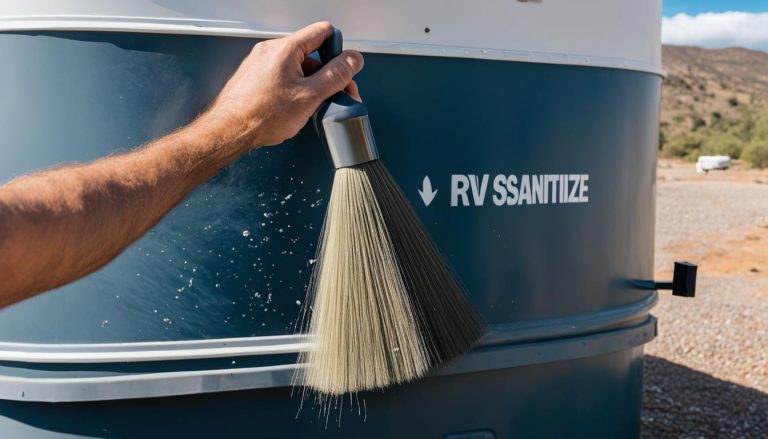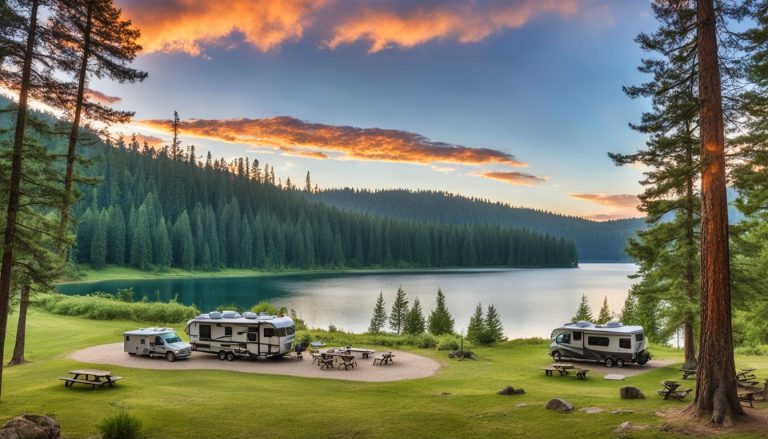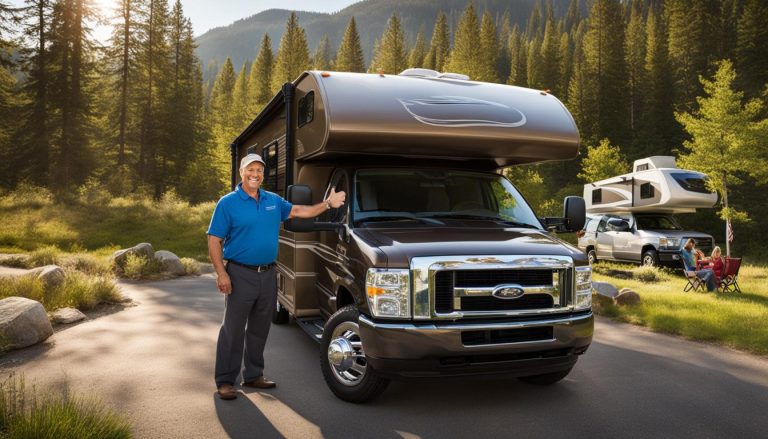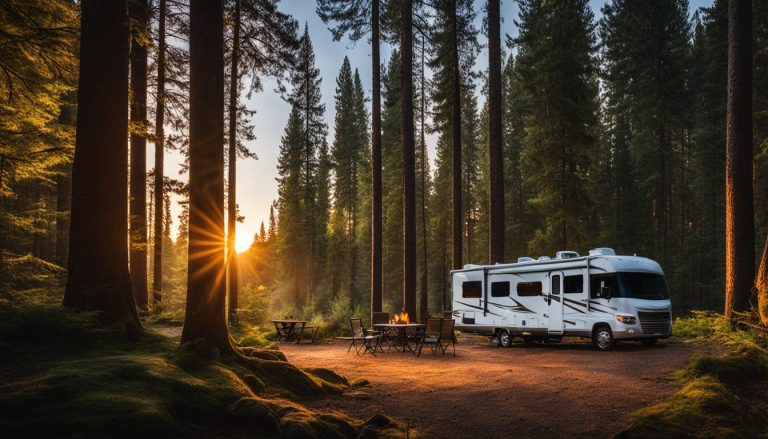RV Fridge Fix Guide: Repair It Yourself Easily!
gorvlifestyle.com and its partners may earn a commission if you purchase a product through one of our links
If you’re experiencing issues with your RV fridge, don’t worry! With the right knowledge and a little DIY effort, you can easily fix common problems and get your refrigerator running smoothly again. In this guide, we will provide step-by-step instructions on how to troubleshoot and repair your RV fridge, whether it’s a Dometic or Norcold refrigerator. By following these tips, you can save money on expensive repairs and get back to enjoying your RV adventures in no time.
Key Takeaways
- Repairing a broken RV fridge is possible with the right knowledge and DIY effort.
- Understanding how your RV refrigerator works is crucial for troubleshooting.
- Electrical issues can cause problems with your RV fridge – check the power source, fuses, and circuit breakers.
- Propane issues can also affect your RV fridge – check the LP tank, thermocouple, and burner area.
- Regular maintenance, such as cleaning and inspecting the refrigerator, is essential for longevity.
Understanding How Your RV Refrigerator Works
Before you start repairing your RV refrigerator, it’s helpful to understand how it works. Unlike residential refrigerators, RV refrigerators are gas absorption refrigerators that operate using a mixture of hydrogen gas, ammonia water, and sodium chromate. The cooling unit in an RV fridge is responsible for circulating this mixture and cooling the refrigerator. By familiarizing yourself with these key components, you’ll be better equipped to troubleshoot and repair any issues that may arise.
Gas absorption refrigerators, like those found in RVs, work on a unique principle that doesn’t rely on compressors or motors. Instead, they use heat to create a cooling effect. The process starts with the ammonia mixture, which is located in the cooling unit.
The cooling unit consists of several components, including the generator, condenser, evaporator, and absorber. These components work together to facilitate the absorption, evaporation, and condensation of the ammonia mixture, ultimately creating a cooling effect that keeps your food and beverages cold.
“Understanding how your RV refrigerator works is crucial for effective troubleshooting and repair. By knowing how the cooling unit operates, you’ll be able to pinpoint the source of the problem and make the necessary fixes.”
When the RV fridge is operating, the generator uses a heat source, such as propane or AC power, to heat the ammonia mixture. This causes the ammonia to vaporize and rise to the condenser, where it cools and liquefies. The liquefied ammonia then flows to the evaporator, where it mixes with hydrogen gas. As the mixture evaporates, it absorbs heat from the interior of the refrigerator, cooling the contents.
Once the ammonia mixture has absorbed the heat, it flows to the absorber, where it combines with water and sodium chromate. This mixture then returns to the generator to start the process all over again.
Understanding how your RV refrigerator works, specifically the gas absorption process and the key components involved, allows you to diagnose and troubleshoot common issues. Whether you’re dealing with a cooling problem, a leaking refrigerator, or an ignitor failure, having this knowledge will empower you to confidently tackle the necessary repairs.
Troubleshooting Electrical Issues with Your RV Fridge
If your RV fridge is not running on electricity, it can be frustrating and inconvenient. However, there are several troubleshooting steps you can take to address these electrical issues and get your fridge back up and running.
1. Check the Power Supply
The first step is to ensure that your RV’s 120-volt AC power is reaching the refrigerator. Begin by checking the power cord and making sure it is securely connected. If the power cord is damaged or frayed, it may need to be replaced. Next, inspect the circuit breakers and fuses at the back of the fridge. A tripped or blown fuse can disrupt the power supply to the refrigerator.
2. Test the Heating Element
The heating element is responsible for generating the heat necessary to cool the refrigerator. If the heating element is faulty, it may prevent the fridge from running on electricity. To test the heating element, you will need a multimeter. Disconnect the power supply and locate the heating element at the back of the fridge. Use the multimeter to check for continuity, ensuring that electricity can flow through the heating element. If there is no continuity, the heating element may need to be replaced.
3. Check Circuit Breakers
In addition to the circuit breakers located at the back of the fridge, there may be other circuit breakers throughout your RV’s electrical system. Check the main circuit breaker panel and any other circuit breakers related to the fridge. If a breaker is tripped, reset it and see if the fridge begins running on electricity.
If you have completed these troubleshooting steps and the issue persists, it’s recommended to seek professional assistance. Dealing with electrical issues can be dangerous, and it’s best to leave them to the experts to avoid any potential hazards.
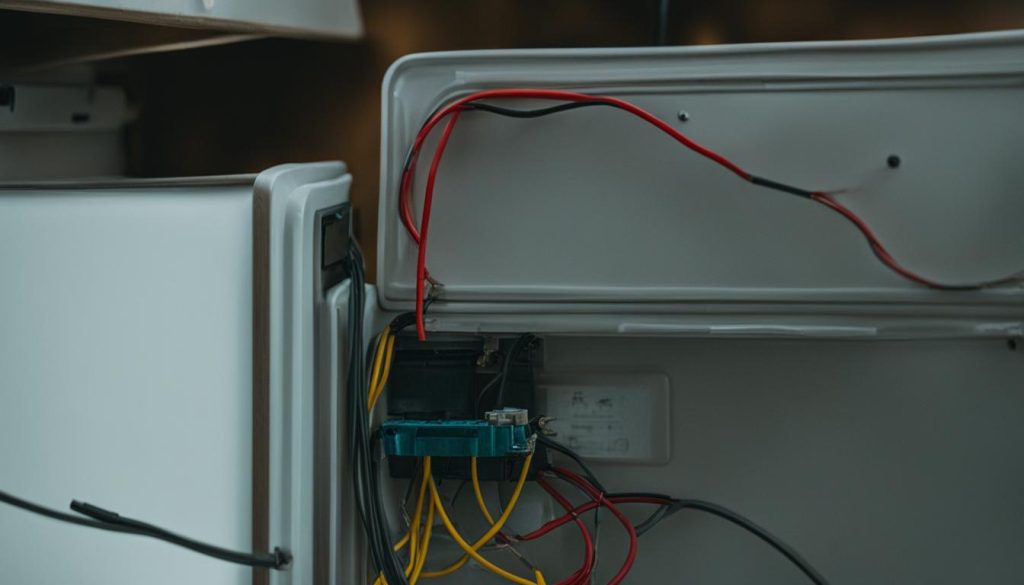
| Issue | Possible Cause | Solution |
|---|---|---|
| No electricity in RV fridge | Disconnected power cord, blown fuse, tripped circuit breaker | – Check power cord connection – Inspect and replace blown fuse – Reset tripped circuit breakers |
| Heating element not working | Faulty heating element | – Test heating element for continuity – Replace faulty heating element |
By following these troubleshooting steps, you can identify and resolve electrical issues with your RV fridge, ensuring that it runs smoothly and keeps your food fresh during your adventures on the road.
Troubleshooting Propane Issues with Your RV Fridge
If your RV fridge is not running on propane, it’s important to troubleshoot the propane system for any potential issues. By following these steps, you can identify and resolve common problems that may be affecting the performance of your RV fridge. Here are some key troubleshooting tips:
1. Checking the LP Tank
Start by checking the LP (liquid propane) tank to ensure it’s not running low on fuel. Low fuel levels can prevent the fridge from operating properly. Additionally, make sure the LP tank valves are open to allow propane flow to the fridge. Here are the steps to follow:
- Inspect the LP tank gauge to ensure there is sufficient propane supply.
- If the tank gauge shows low propane levels, it’s advisable to refill the tank before troubleshooting further.
- If the tank gauge shows sufficient propane levels, check that the valves on the tank are fully open.
2. Faulty Thermocouple
If the burner in your RV fridge is not staying lit, the thermocouple may be faulty and in need of replacement. The thermocouple is an important safety device that senses the presence of a flame and prevents gas flow if no flame is detected. Here’s how you can check and replace a faulty thermocouple:
- Locate the thermocouple near the burner area of the fridge.
- Carefully remove the old thermocouple by unscrewing it from the gas valve.
- Replace it with a new thermocouple that is compatible with your RV fridge model.
- Make sure to tighten the connection securely.
3. Cleaning the Burner Area
Over time, the burner area of your RV fridge can accumulate dirt, debris, and rust, which can affect the quality of the propane flame and hinder its performance. Regularly cleaning the burner area can help improve the functioning of your fridge. Here’s how you can clean the burner area:
- Turn off the propane supply and ensure there is no open flame or source of ignition nearby.
- Remove the burner cover to access the burner area.
- Using a soft brush or compressed air, remove any debris or dirt from the burner and surrounding area.
- Inspect for any signs of damage or blockage and address accordingly.
- Reassemble the burner cover and ensure it is securely in place.
By following these troubleshooting steps, you can effectively resolve propane-related issues with your RV fridge. However, if the problem persists or you’re unsure about performing the repairs yourself, it’s always recommended to consult a professional technician to ensure your safety and the proper functioning of your RV fridge.
| Problem | Possible Cause | Solution |
|---|---|---|
| Burner not staying lit | Faulty thermocouple | Replace thermocouple |
| Poor flame quality | Dirty burner area | Clean burner area |
| No propane flow | Low LP tank fuel or closed valves | Refill LP tank or open valves |
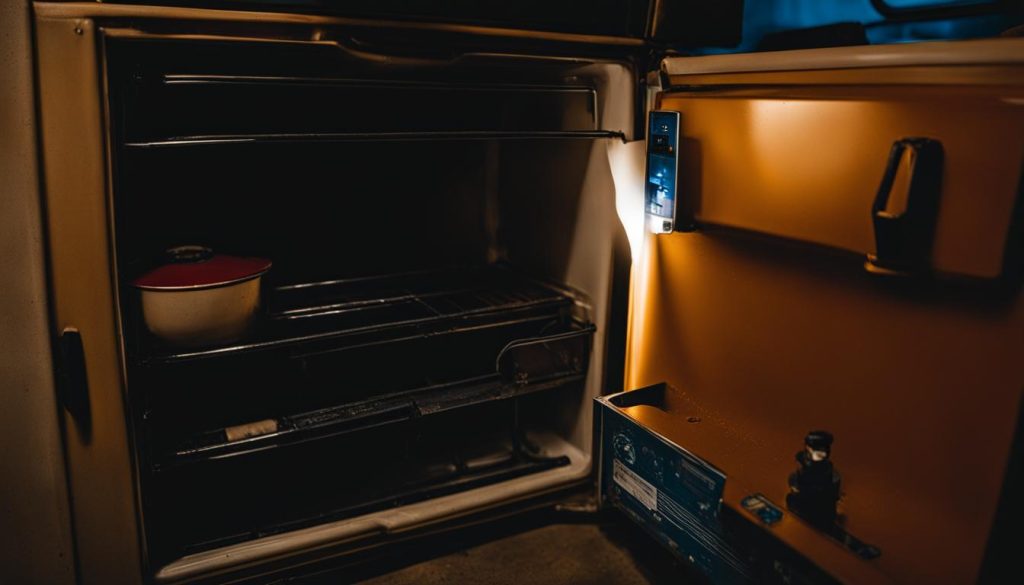
Maintaining Your RV Refrigerator for Longevity
Regular maintenance is essential for ensuring the longevity of your RV refrigerator. By following a few simple steps, you can keep your fridge running smoothly and prevent costly repairs. One important aspect of maintenance is using the right power source for your refrigerator. Depending on your camping conditions, choose either propane or AC power as the appropriate power source for optimal performance.
Keeping the exterior of your refrigerator clean is another crucial maintenance task. Regularly wipe down the refrigerator, paying special attention to the cooling unit coils. This prevents the accumulation of dirt and debris that can hinder the fridge’s efficiency. By keeping the exterior clean, you’ll ensure that your fridge can cool effectively, even during hot summer camping trips.
Regular maintenance should also be performed before storing your RV. Cleaning and inspecting the refrigerator is an important step to identify any potential issues. Check for any signs of wear and tear, loose connections, or leakage. By addressing these issues before storing your RV, you can avoid unexpected breakdowns and ensure a hassle-free experience on your next trip.
FAQ
How do I troubleshoot and repair my RV fridge?
To troubleshoot and repair your RV fridge, start by understanding how it works and familiarizing yourself with its key components. Then, you can address any electrical issues, check the propane system, and perform regular maintenance to ensure its longevity.
What should I do if my RV fridge is not running on electricity?
If your RV fridge is not running on electricity, check the 120-volt AC power, inspect the fuses and circuit breakers, and test the heating element using a multimeter. If the problem persists, seek professional assistance.
What should I do if my RV fridge is not running on propane?
If your RV fridge is not running on propane, check the LP tank to ensure it’s not low on fuel and that the valves are open. If the burner is not staying lit, replace the thermocouple and clean the burner area and orifice.
How can I maintain my RV refrigerator for longevity?
To maintain your RV refrigerator for longevity, use the appropriate power source, keep the exterior and cooling unit coils clean, and perform regular maintenance, including cleaning and inspection, before storing your RV.

